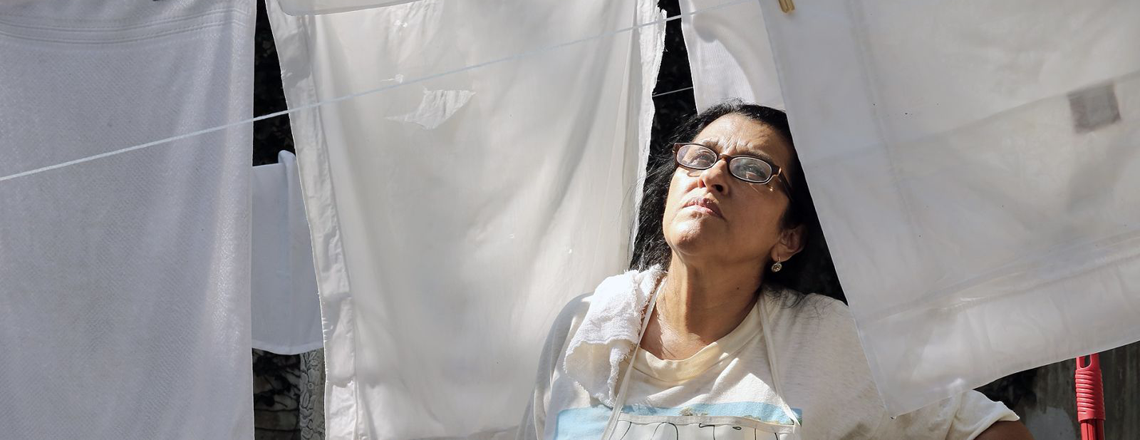
Thomas Humphrey reviews Anna Muylaert’s sentimental and socially-minded “The Second Mother”, a heartwarming drama centered on a strong performance by Regina Casé as a Brazilian live-in maid.
Anna Muylaert’s The Second Mother affectionately tells the story of Val, an endearing live-in maid who leaves her daughter Jéssica and goes to look after somebody else’s child instead. She does this with great difficulty, but as a single mother she perseveres in order to support her child. In fact, by the time we enter the frame, she seems to be carrying out her job with such great, down-to-earth gusto and matronly charm, it’s almost as if she has come to enjoy her escape into subservience. That is until her daughter’s unexpected arrival on the scene causes her to question her behavior, and we see her submissive veneer slowly begin to fade away.
Val’s struggle is often filled with a moving sense of separation, preventing The Second Mother from purely being a simple story of rising aspirations and social mobility. In the opening scene, for example, we sadly observe her trying to connect with her distant and reticent daughter over the phone, all whilst her new newly entrusted surrogate gazes on with bemusement. The strange sacrificial selflessness which Val repeatedly shows in scenes like this is certainly full of pathos and quickly sucks you into a rich emotional narrative. Under its original title, too – the much more emotive Que Horas Ela Volta? (meaning “When is She Coming Back?”) – this film much more explicitly catches and analyzes an entire society which seems to be unnaturally detached from, and deeply longing for, a loving mother figure.
This problem of a missing matriarch often becomes entangled in issues of class and capitalism along the way, and as such Muylaert’s story is very much caught between two worlds, making it incredibly representative of the transitional zeitgeist of Brazil today. This culture of low-paid hired servants and nannies, for example, was once a common, prominent feature of Brazilian life. But in recent years – amidst a general mood for change – these workers have had their rights protected, meaning maids are now mostly a “luxury” tradition preserved only for the super-rich. Whilst positive, this cultural shift has therefore created some remarkably profound and visible social contrasts, something which Muylaert and other Brazilian directors have been keen to zero in on in their films.
So in the case of The Second Mother, we see a family who has it all living it up in a gargantuan house, whilst the maid they so dependently rely on is confined to living in a little cubby-hole, out of sight. Indeed, the house itself – its architecture and coded design of the domestic space – plays a fundamental role in illustrating the divisions inherent in this film’s attractive Brazilian microcosm. In the early stages, we repeatedly see people channelled through this space via imposing, narrow corridors, or see them separated, distanced or flanked by walls and doorways which fill and tunnel our view.
In fact, this presence of a house as almost a character might put followers of contemporary Brazilian cinema in mind of Fellipe Barbosa’s Casa Grande, which also took a long, hard look at the culture of privilege that runs through Brazil’s upper middle class today. Deep at the heart of that film sat another large, modern, imposing mansion too, and this brooding, almost always present figure clearly communicated how hemmed-in its bourgeois inhabitants were in a world of their own making. Both filmmakers therefore seem incredibly determined to illustrate how insulating and sedative the domestic spaces of the Brazilian upper middle class can be, helping its inhabitants plaster over the cracks of society in the process.
However, Barbosa’s story had none of the humanity and idiosyncratic zest with which Muylaert manages to paint her second mother. Whilst her steady psychological and emotional deep-focus may not be for everyone, The Second Mother certainly is a character piece of a high order. The director’s incredible ability to create a truly character-driven story is something well worth praising, as is the attention she lavishes on her beautifully well-rounded female characters. As a result the overall impact of Val’s story is also surprisingly uplifting, as she proves to be an utterly wonderful blend of old-school “knowing your place” and humorous, working-class moxie, making her journey impossible not to love, especially if you are a fan of good emotional dramas.
This excellent persona, carried by Regina Casé’s stellar performance, really does sweep you up in her narrative. But the kind of “know your place” mentality which Val represents certainly soon erodes and is swept away when the unexpected tidal wave of her daughter’s persona arrives. Full of that sort of omnipotent swagger of a woman right at the sweet spot of her youthful prime, Jéssica arrives like a torrent – washing away all the cultural norms that stand in her way. Upwardly socially mobile and utterly a product of her age, Jéssica is one woman who will not tolerate the class codes of her mother’s generation. And the tension created as a result is then so fantastically acted out that it is hard not to find it quite compelling.
But as we slowly come to see what an admirable figure Jéssica is, pride causes something to awaken and grow in Val and as a result we see almost a narrative of emancipation, an almost representative liberation of an entire class waking up to, and shaking free from, its shackles. The declarations of independence in this film only come in the smallest of forms, whether they be dips in an exclusive pool, a snaffled scoop of ice-cream or a dream of a good education patiently earned. Though The Second Mother is also always a story of familial reconciliation, so whilst it may be a bit too sentimental or socially-minded for some, people who enjoy watching a film with heart, or seeing the new perspectives that that South American cinema has to offer, should enjoy this film.
The Second Mother is out now in limited cinemas.
Fonte: CinemaJam







